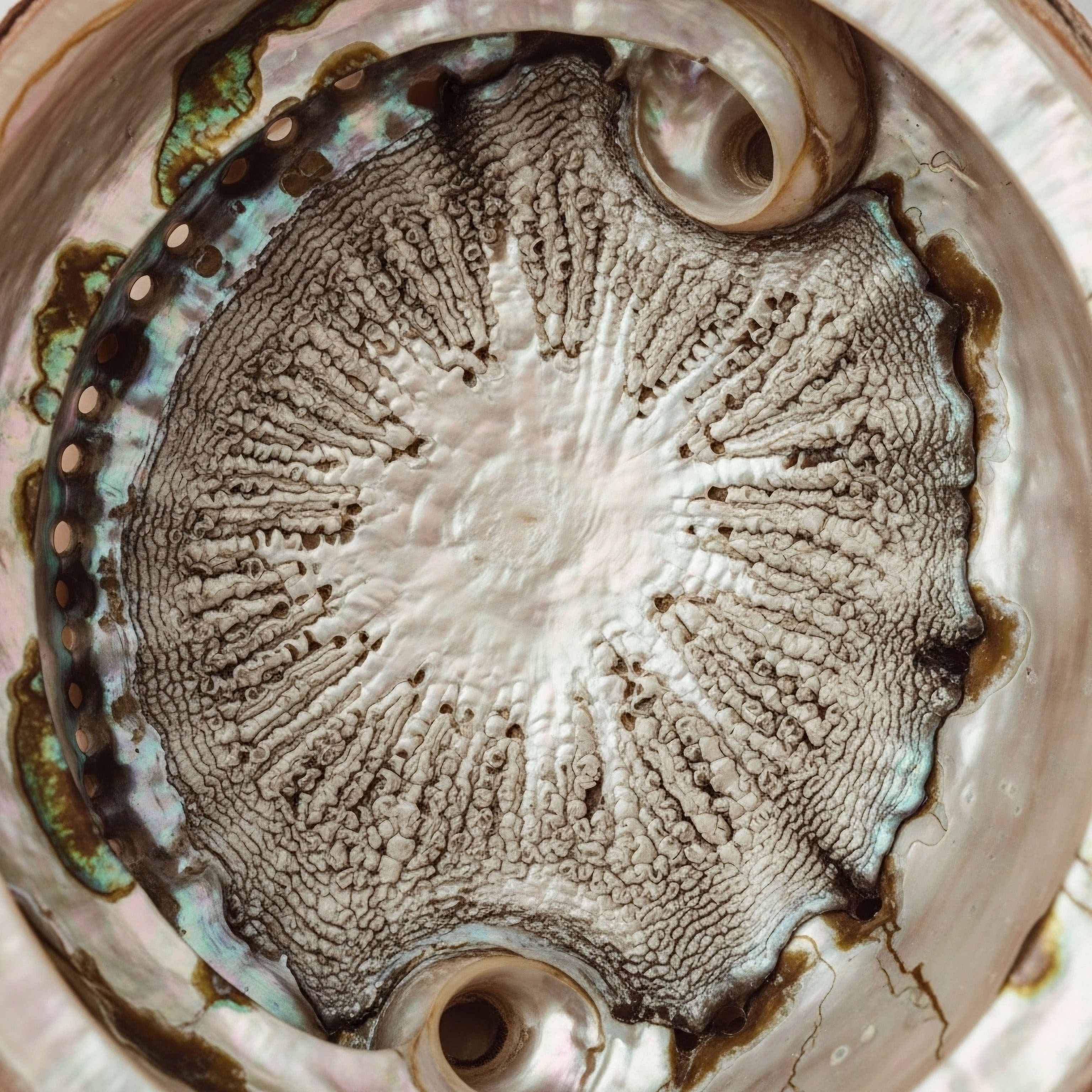

Fundamentals
The feeling is unmistakable. It is a subtle, persistent sense that your body’s internal settings are miscalibrated. Energy levels are unpredictable, sleep fails to restore, and a fog settles over your thoughts. You may have attributed these shifts to age, stress, or the demands of a busy life.
Your lived experience of this gradual decline in vitality is the most important data point you possess. It is the first signal that the intricate communication network within your body, the endocrine system, requires attention. The way you nourish your body directly informs this system, acting as a set of instructions that can either clarify or scramble its signals. Understanding this connection is the first step toward reclaiming your biological functionality.
Your endocrine system is a sophisticated orchestra of glands that produce and release hormones, the chemical messengers that regulate nearly every process in your body. These messengers travel through your bloodstream, delivering precise instructions to distant cells and organs. They dictate your metabolism, your stress response, your reproductive cycles, your mood, and your capacity for growth and repair.
For this system to function correctly, it requires specific raw materials. These materials are derived directly from the foods you consume. The quality of your diet, therefore, becomes the foundation upon which your entire hormonal architecture is built.
The foods you eat provide the essential building blocks and regulatory signals that govern your entire hormonal network.

The Building Blocks of Hormones
Hormones are not created from thin air. Their synthesis depends on a steady supply of macronutrients and micronutrients. The choices you make at every meal contribute to the pool of resources available for this critical manufacturing process. A diet lacking in these foundational components can lead to compromised hormone production, creating a cascade of downstream effects that manifest as the symptoms you may be experiencing.
Consider the primary categories of hormones and their dietary origins:
- Steroid Hormones ∞ This class includes testosterone, estrogens, and cortisol. Their molecular backbone is cholesterol. Dietary fats, particularly from sources like olive oil, avocados, nuts, and responsibly sourced animal products, provide the necessary cholesterol for their production. A low-fat diet, especially one that severely restricts healthy fats, can directly impair the body’s ability to synthesize these vital hormones.
- Peptide and Protein Hormones ∞ This group includes insulin, growth hormone, and the hormones that regulate appetite. They are constructed from amino acids, the building blocks of protein. Adequate intake of high-quality protein from sources like lean meats, fish, eggs, and legumes is essential for their creation. A deficiency in dietary protein can limit the production of these hormones, affecting everything from blood sugar control to muscle maintenance.
- Thyroid Hormones ∞ These hormones, which govern your metabolic rate, are synthesized from the amino acid tyrosine and the mineral iodine. Tyrosine is found in protein-rich foods, while iodine is present in seafood, seaweed, and iodized salt. A diet insufficient in either of these can directly impede thyroid function, leading to symptoms of fatigue and weight gain.

How Food Sends Signals to Your Endocrine System
Your diet does more than just provide raw materials. It actively modulates hormonal signaling. The composition of your meals, particularly the balance of carbohydrates, proteins, and fats, triggers specific hormonal responses. The most immediate and powerful of these is the insulin response. When you consume carbohydrates, they are broken down into glucose, which enters your bloodstream. Your pancreas responds by releasing insulin, a hormone whose job is to shuttle glucose out of the blood and into your cells for energy.
A diet high in refined carbohydrates and sugars causes rapid, large spikes in blood glucose, demanding a forceful insulin response. Over time, this can lead to a condition known as insulin resistance, where your cells become less responsive to insulin’s signals. This state of metabolic dysfunction has profound implications for your entire endocrine system.
High circulating insulin levels can suppress growth hormone production, alter the balance of sex hormones like testosterone and estrogen, and place a significant strain on your adrenal glands. Managing blood sugar through a diet rich in fiber, protein, and healthy fats is a primary strategy for supporting overall hormonal health. A balanced dietary pattern ensures a more stable, controlled release of insulin, preserving cellular sensitivity and promoting a healthier endocrine environment.


Intermediate
Moving beyond foundational knowledge, we can begin to connect specific dietary strategies to the efficacy of clinical endocrine support protocols. When you undertake a therapy like Testosterone Replacement Therapy (TRT) or Growth Hormone Peptide Therapy, you are introducing powerful signals into your body. The success of these interventions is not solely dependent on the medication itself.
The nutritional environment you create can either amplify their benefits or create metabolic headwinds that hinder progress. Your diet becomes an active variable in the therapeutic equation, capable of shaping outcomes in a measurable way.
The primary mechanism through which diet influences hormonal therapies is its effect on insulin sensitivity and inflammation. A state of chronic inflammation and insulin resistance, often driven by a diet high in processed foods and sugar, can blunt the body’s ability to properly utilize and respond to hormonal signals, including those introduced therapeutically. Conversely, a dietary pattern that stabilizes blood sugar and reduces inflammation creates a more receptive cellular environment, allowing protocols like TRT and peptide therapy to function optimally.

Optimizing Testosterone Replacement Therapy through Diet
For both men and women undergoing TRT, dietary choices can significantly impact the therapy’s effectiveness and side-effect profile. The goal is to create a metabolic state that supports the actions of testosterone while managing its potential conversion to estrogen.

Managing Aromatase Activity
Testosterone can be converted into estrogen through the action of an enzyme called aromatase. This process is a natural and necessary part of hormonal balance, but excessive aromatase activity can lead to an unfavorable testosterone-to-estrogen ratio, potentially causing side effects. Aromatase activity is known to be higher in adipose (fat) tissue. Therefore, a key dietary strategy is to maintain a healthy body composition.
Dietary patterns that promote fat loss and reduce inflammation can help manage aromatase. Specific foods may also play a role:
- Cruciferous Vegetables ∞ Broccoli, cauliflower, and cabbage contain compounds like indole-3-carbinol, which can support healthy estrogen metabolism in the liver.
- Zinc-Rich Foods ∞ Oysters, red meat, and pumpkin seeds are excellent sources of zinc, a mineral that has been shown to have a moderating effect on aromatase activity.
- Healthy Fats ∞ Omega-3 fatty acids from fish and monounsaturated fats from olive oil help reduce systemic inflammation, which can contribute to elevated aromatase.

The Role of Carbohydrate Management
The amount and type of carbohydrates consumed can have a direct impact on TRT. High-glycemic carbohydrates can lead to insulin spikes, which may negatively affect sex hormone-binding globulin (SHBG), a protein that binds to testosterone in the blood. Lower SHBG can mean more free testosterone, but the overall hormonal milieu is often less stable.
A diet focused on low-glycemic, high-fiber carbohydrates from vegetables and whole grains helps maintain stable blood sugar and insulin levels, creating a more favorable environment for hormone balance.
A diet that stabilizes blood sugar and reduces inflammation creates a more receptive cellular environment for hormonal therapies to exert their effects.
Some individuals find that a very-low-carbohydrate ketogenic diet (KD) can be beneficial. Studies have shown that in certain contexts, particularly those involving weight loss, a KD can lead to an increase in total testosterone levels. This is thought to be related to the high intake of dietary fats providing cholesterol, the precursor to testosterone, and the significant reduction in body fat. However, the response is highly individual and should be monitored.

Supporting Growth Hormone Peptide Therapy
Growth hormone secretagogues (GHSs), such as Sermorelin and Ipamorelin, work by stimulating the pituitary gland to release its own growth hormone (GH). The effectiveness of this stimulation is highly sensitive to your metabolic state at the time of administration, which is directly influenced by your diet.
GH release is naturally blunted by high levels of blood glucose and insulin. To maximize the pulse of GH from a peptide injection, it is crucial to administer it in a fasted state or at a time when blood sugar is low.
This typically means injecting first thing in the morning and waiting at least 30-60 minutes before consuming food, or injecting at night at least 2-3 hours after the last meal. Consuming a meal high in carbohydrates immediately before or after an injection can significantly reduce the peptide’s effectiveness.

Table Dietary Approaches and Endocrine Support
Different dietary patterns can be strategically employed to support specific therapeutic goals. The table below outlines two common patterns and their relevance to hormonal health protocols.
| Dietary Pattern | Core Principles | Relevance to Endocrine Support |
|---|---|---|
| Mediterranean Diet |
Rich in whole foods, vegetables, fruits, legumes, nuts, seeds, and olive oil. Moderate consumption of fish and poultry. Low in red meat and processed foods. |
Excellent for long-term health. Its anti-inflammatory properties and positive effects on insulin sensitivity create a supportive baseline for any hormonal therapy. Particularly beneficial for managing cardiovascular risk factors and supporting overall well-being during menopause. |
| Ketogenic Diet (KD) |
Very low carbohydrate, high fat, moderate protein. Shifts the body’s primary fuel source from glucose to ketones. |
Can be a powerful tool for rapid fat loss and improving insulin sensitivity. May increase total testosterone levels, especially when combined with weight loss. The low-insulin state can potentiate the effects of growth hormone secretagogues. Requires careful monitoring and may not be suitable for everyone long-term. |

What Is the Best Dietary Strategy for Hormone Optimization?
There is no single “best” diet. The optimal nutritional strategy is one that is tailored to your individual physiology, goals, and the specifics of your therapeutic protocol. For most individuals, a whole-foods-based approach, similar to a Mediterranean pattern, provides a robust and sustainable foundation.
It effectively manages inflammation and insulin sensitivity, the two most critical factors for supporting endocrine health. More specialized approaches like a ketogenic diet can be used as targeted interventions for specific goals, such as breaking through a weight-loss plateau or maximizing insulin sensitivity, often for a defined period. The key is to view diet as a dynamic tool that can be adjusted to meet the evolving needs of your body as you progress on your health journey.


Academic
A sophisticated understanding of dietary influence on endocrine therapies requires moving beyond macronutrient ratios and into the complex, bidirectional communication between the gut microbiome and the human endocrine system. The gut is not a passive tube for digestion; it is an active endocrine organ in its own right, populated by trillions of microbes that produce and modulate a vast array of bioactive compounds.
A specific collection of these microbes, termed the estrobolome, plays a direct and critical role in the metabolism of estrogens. The composition and function of the estrobolome, which is profoundly shaped by dietary patterns, can determine the fate of both endogenous and exogenous hormones, making it a pivotal factor in the success of hormonal optimization protocols for both men and women.

The Estrobolome and Enterohepatic Recirculation
Estrogens, after being produced in the ovaries, adrenals, or from the aromatization of androgens, are sent to the liver for metabolism. In the liver, they are conjugated ∞ essentially packaged for disposal ∞ by attaching a glucuronic acid molecule. This conjugated estrogen is then excreted into the bile, which flows into the gut.
Here, the estrobolome intervenes. Certain gut bacteria produce an enzyme called β-glucuronidase. This enzyme can deconjugate estrogen, cleaving off the glucuronic acid molecule and returning the estrogen to its active, unconjugated form. This free estrogen can then be reabsorbed from the gut back into the bloodstream, a process known as enterohepatic recirculation.
The activity level of the estrobolome creates a regulatory dial for the body’s estrogen load. A healthy, diverse microbiome maintains a balanced level of β-glucuronidase activity, allowing for appropriate excretion of excess estrogen. However, a state of gut dysbiosis ∞ an imbalance in the microbial community ∞ can alter this process significantly.
An overgrowth of β-glucuronidase-producing bacteria can lead to excessive deconjugation and reabsorption of estrogens, contributing to a state of estrogen dominance. Conversely, a depleted microbiome may lead to insufficient reabsorption, potentially causing low estrogen levels.
The gut microbiome, particularly the estrobolome, directly regulates circulating estrogen levels by modulating their reabsorption from the gut.

Implications for Hormonal Therapies
This mechanism has profound implications for individuals on hormonal therapies.
- For Women on HRT ∞ The efficacy and safety of estrogen therapy can be influenced by the state of the estrobolome. A dysbiotic gut that excessively recycles estrogen could potentially increase the risk of estrogen-sensitive conditions. Supporting a healthy microbiome is a key strategy for ensuring that administered estrogen is metabolized and excreted appropriately.
- For Men on TRT ∞ Men also rely on a healthy balance of testosterone and estrogen. Testosterone is converted to estrogen via the aromatase enzyme. If a man on TRT also has a dysbiotic gut with high β-glucuronidase activity, the estrogen produced via aromatization can be excessively recycled, potentially exacerbating estrogen-related side effects like gynecomastia or water retention. Even with the use of an aromatase inhibitor like Anastrozole, managing the gut-level recirculation of estrogen is a critical, often overlooked, component of a successful protocol.

How Does Diet Shape the Estrobolome?
The composition of the gut microbiome is highly responsive to dietary inputs. The foods you eat selectively feed different populations of bacteria, thereby shaping the overall microbial landscape and the activity of the estrobolome.
A diet high in processed foods, sugar, and unhealthy fats, and low in fiber, tends to promote dysbiosis. It can reduce overall microbial diversity and favor the growth of bacteria that may contribute to inflammation and hormonal imbalance. In contrast, a diet rich in plant-derived nutrients can cultivate a healthy, diverse microbiome that supports hormonal homeostasis.

Table Dietary Components and Their Effect on the Gut Microbiome
The following table details specific dietary components and their documented effects on the gut microbiome and, by extension, the estrobolome.
| Dietary Component | Mechanism of Action | Impact on Estrobolome and Hormonal Health |
|---|---|---|
| Dietary Fiber (Prebiotics) |
Found in vegetables, fruits, legumes, and whole grains. Acts as a substrate for beneficial gut bacteria, which ferment it to produce short-chain fatty acids (SCFAs) like butyrate. |
Promotes microbial diversity. SCFAs help maintain the integrity of the gut lining, reducing systemic inflammation. A high-fiber diet is associated with lower β-glucuronidase activity and healthier estrogen metabolism. |
| Phytoestrogens |
Plant-derived compounds with a similar structure to estrogen, found in foods like flaxseeds (lignans) and soy (isoflavones). |
Can be metabolized by the gut microbiota into active compounds. For example, lignans are converted to enterolactone, which has weak estrogenic activity and can help modulate estrogen signaling. The ability to perform this conversion depends on having the right gut bacteria. |
| Polyphenols |
Antioxidant compounds found in berries, dark chocolate, green tea, and red wine. |
Exert a prebiotic-like effect, encouraging the growth of beneficial bacteria while inhibiting pathogenic strains. They help reduce oxidative stress and inflammation, creating a healthier gut environment that supports balanced estrobolome function. |
| Probiotic Foods |
Contain live beneficial bacteria, found in fermented foods like yogurt, kefir, sauerkraut, and kimchi. |
Directly introduce beneficial species, such as Lactobacillus and Bifidobacterium, into the gut. These species can help improve gut barrier function, modulate the immune system, and compete with less desirable microbes, thereby supporting a more balanced estrobolome. |
In a clinical context, optimizing a patient’s diet to support a healthy gut microbiome should be considered a foundational element of any endocrine support protocol. Assessing and addressing gut health through targeted dietary interventions ∞ emphasizing fiber, phytonutrients, and fermented foods ∞ can create a more predictable and effective response to hormonal therapies.
This systems-biology approach, which recognizes the deep interconnection between diet, the microbiome, and the endocrine system, represents a more complete and personalized model for achieving and maintaining hormonal balance.

References
- Baker, J. M. Al-Nakkash, L. & Herbst-Kralovetz, M. M. (2017). Estrogen-gut microbiome axis ∞ Physiological and clinical implications. Maturitas, 103, 45 ∞ 53.
- Kwa, M. Plottel, C. S. Blaser, M. J. & Adams, S. (2016). The Estrobolome ∞ The Gut Microbiome and Estrogen. Journal of the National Cancer Institute, 108 (8), djw024.
- Ervin, S. M. Li, H. Lim, L. Roberts, L. R. & Chia, N. (2019). Gut microbial beta-glucuronidases ∞ a key to unlock the puzzle of drug-induced toxicity. Drug Metabolism and Disposition, 47 (9), 992-999.
- Qi, X. Yun, C. Pang, Y. & Qiao, J. (2021). The impact of the gut microbiota on the reproductive and metabolic endocrine system. Endocrinology, 162 (8), bqab102.
- Barrea, L. Arnone, A. Annunziata, G. Muscogiuri, G. Laudisio, D. Salzano, C. & Colao, A. (2021). Adherence to the Mediterranean diet, dietary patterns and body composition in women with polycystic ovary syndrome (PCOS). Nutrients, 13 (8), 2759.
- Gacci, M. et al. (2023). Ketogenic state improves testosterone serum levels-results from a systematic review and meta-analysis. Endocrine, 79 (2), 273-282.
- Volek, J. S. et al. (2020). Effects of ketogenic dieting on body composition, strength, power, and hormonal profiles in resistance training men. Journal of Strength and Conditioning Research, 34 (12), 3463-3474.
- Hersey, M. et al. (2022). The Mediterranean diet and its association with menopausal symptoms ∞ a cross-sectional study. Menopause, 29 (1), 49-57.
- Lan, Y. et al. (2022). Regulation of GH and GH Signaling by Nutrients. Cells, 11 (5), 839.
- Laferrère, B. et al. (2005). Growth hormone releasing peptide-2 (GHRP-2), a ghrelin agonist, increases appetite and food intake in healthy, normal-weight men. The Journal of Clinical Endocrinology & Metabolism, 90 (2), 811-814.

Reflection

Calibrating Your Internal Environment
You have now seen how the food on your plate translates into the chemical language of your body. This knowledge shifts the perspective on diet from one of restriction to one of intentional communication. Each meal is an opportunity to send a clear, coherent message to your endocrine system, a chance to provide the precise resources it needs to function with vitality.
The symptoms that initiated your journey for answers are not isolated events; they are signals from a complex, interconnected system that is responsive to your choices.
Consider your own daily patterns. How do your food choices make you feel, not just in the moment, but hours later? What is the relationship between your energy, your mood, and what you have consumed? This process of self-awareness, of connecting your internal experience with your external actions, is the essence of a personalized health journey.
The information presented here is a map, but you are the one navigating the territory of your own unique biology. The path forward involves listening to your body’s feedback with the same attention you would give to a trusted advisor. This journey is about building a collaborative partnership with your own physiology, using informed choices to guide your body back to its inherent state of balance and strength.



